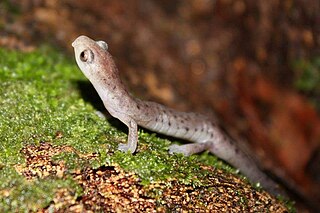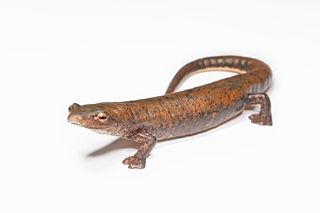
Hynobius yangi, the Kori salamander, is a species of salamander endemic to southeastern South Korea. It is a lentic-breeding species similar to the Korean salamander but is distinguished by factors including tail shape and dorsal coloration. The species is known from the vicinity of the type locality in Gijang County in northeastern Busan and from the nearby Ulju County in western Ulsan.

Alvarado's salamander, also known as the Moravia de Chirripo salamander, is a species of salamander in the family Plethodontidae.

The La Loma salamander is a species of salamander in the family Plethodontidae. It is found in Costa Rica and western Panama. The common name refers to La Loma, its type locality on the trail between Chiriquicito and Boquete, earlier in the Bocas del Toro Province but at present in the Ngäbe-Buglé Comarca, Panama. Its natural habitats are humid lowland and montane forests. It is largely an arboreal species living in bromeliads, but it can be found on the ground too. It is threatened by habitat loss.
Bolitoglossa engelhardti is a species of salamander in the family Plethodontidae. It is found in the extreme south-eastern Chiapas, Mexico, and eastward along the Pacific versant to Volcán Atitlán in south-western Guatemala. It is named for Teodoro Engelhardt, Guatemalan plantation owner who entertained Karl Patterson Schmidt and his expedition. Its common names include Engelhardt's salamander, Engelhardt's mushroomtongue salamander, and Engelhardt's climbing salamander.
Hartweg's climbing salamander, also known as Hartweg's mushroomtongue salamander, and Hartweg's salamander, is a species of salamander in the family Plethodontidae. It is found in the north-central Chiapas, Mexico, and the adjacent Guatemalan Sierra de los Cuchumatanes.
The Paramo Frontino salamander is a species of salamander in the family Plethodontidae. It is endemic to the Western Ranges of the Colombian Andes where it is known from the area of its type locality, Páramo Frontino. It is also known from the Colibri del Sol Bird Reserve near Urrao. both areas are in the Antioquia Department.
Jackson's climbing salamander is a species of salamander in the family Plethodontidae. It is endemic to Guatemala. Its natural habitat is subtropical or tropical moist montane forests. It is threatened by habitat loss. The salamander is among the 25 "most wanted lost" species that are the focus of Global Wildlife Conservation's "Search for Lost Species" initiative, as it had not been seen since 1975. It was rediscovered in 2017 at an amphibian reserve in the Sierra de los Cuchumatanes.
The San Gil climbing salamander, also known as the San Gil mushroomtongue salamander, is a species of salamander belonging to the family Plethodontidae. It is endemic to Colombia, and its natural habitats are tropical highly humid forests; it has also been reported from a coffee plantation. The greatest threat posed to this species is habitat loss, however they are currently nowhere near the risk of extinction. The species' name honors Antoine Rouhaire, a French naturalist who collected the species holotype.
Bolitoglossa orestes, commonly known as the Culata mushroomtongue salamander, is a species of salamander in the family Plethodontidae. It is endemic to the Mérida state of Venezuela.

The Amazon climbing salamander, also known as the Amazon mushroomtongue salamander, is a species of salamander in the family Plethodontidae. It is found on the Amazonian slopes of the Andes of Ecuador and southern Colombia. Its natural habitats are cloud forests. It is threatened by habitat loss and contamination from agricultural operations.

Bolitoglossa pandi is a species of salamander in the family Plethodontidae. It is endemic to the Cundinamarca Department of Colombia and only known from three locations on the western slopes of the Cordillera Oriental, including its type locality, Pandi; it is named after the type locality where it had been collected 50 years before being described as a new species in 1963.
Bolitoglossa porrasorum is a species of salamander in the family Plethodontidae. It is endemic to the mountains of north-central Honduras. Common name Pijol salamander has been proposed for this species in reference to its type locality, Pico Pijol. The specific name porrasorum honors of Jorge Porras Ziuniga and Jorge Porras Orellana, father and son, who provided friendship and assistance to the describers of this species.
The northern banana salamander, also known as common dwarf salamander or rufescent salamander, is a species of salamander in the family Plethodontidae. It is found in the Atlantic slopes of Meso-America from San Luis Potosi, Veracruz, and northern Chiapas in Mexico continuing on to the southern part of Guatemala, Belize, and northern Honduras. However, its range south of Mexico is uncertain because the records may refer to other species.

Savage's salamander, also known as Savage's mushroomtongue salamander, is a species of salamander in the family Plethodontidae. It is endemic to the Sierra Nevada de Santa Marta in northern Colombia. The record from Venezuela represents another species, likely Bolitoglossa guaramacalensis. The species is named after Jay M. Savage, an American herpetologist.

The Cocle salamander, also known as the Cocle mushroomtongue salamander, is a species of salamander in the family Plethodontidae. It is found in Costa Rica and Panama. In Costa Rica, it is only known from the southeastern part of the country on the Atlantic versant, whereas in Panama it is more widespread and occurs also on the Pacific versant. Its natural habitats are humid lowland and montane forests. It is a common species in Panama, whereas it is only known from a single specimen in Costa Rica. It is threatened by habitat loss.
The Veracruz salamander, also known as the Veracruz mushroomtongue salamander, is a species of salamander in the family Plethodontidae. It is endemic to Mexico and known from southern Veracruz, north-eastern Oaxaca, and north-western Chiapas. Its natural habitats are tropical lowland forests, but it occurs also in disturbed habitats. It might be a habitat specialist of limestone outcrops. It is threatened by opening of its habitat by expanding agriculture and wood extraction.
Bolitoglossa nussbaumi is a lungless salamander in the family Plethodontidae endemic to Guatemala.
Bolitoglossa psephena is a lungless salamander in the family Plethodontidae. It is endemic to Guatemala and only known from its type locality, Finca Santa Elena near Chimaltenango. The specific name is derived from the Greek psephena, meaning dark or obscure, and refers to the uniformly dark coloration of this small salamander.

Bolitoglossa cataguana, also known as the Cataguana salamander, is a species of salamander in the family Plethodontidae. It is endemic to Honduras and known from near Cataguana in the Marale municipality, Francisco Morazán Department.
Kentropyx altamazonica, also known commonly as the Cocha whiptail, is a species of lizard in the family Teiidae. The species is native to South America.









